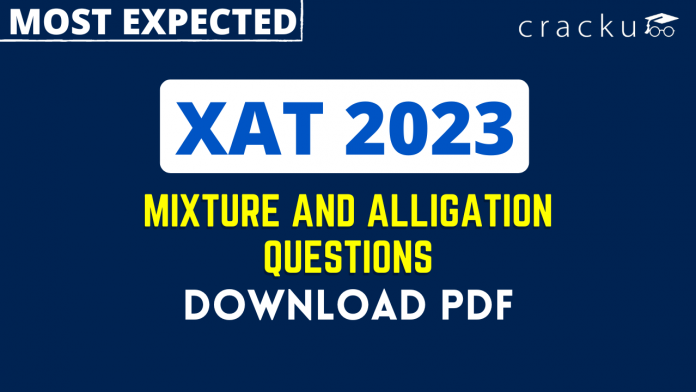XAT Mixture and Alligation Questions PDF [Most Important]
Download Mixture and Alligation Questions for XAT PDF – XAT Mixture and Alligation questions pdf by Cracku. Practice XAT solved Mixture and Alligation Questions paper tests and These sample questions are to analyse the XAT exam pattern. Top 15 very Important Mixture and Alligation Questions for XAT based on asked questions in previous exam papers. The XAT question papers contain actual questions asked with answers, solutions.
Download Mixture and Alligation Questions for XAT
Enroll to XAT 2023 Crash Course
Question 1: Jar A contains ‘X’ litre of pure milk only. A 27 litre mixture of milk and water in the respective ratio of 4 : 5, is added to jar A. The new mixture thus formed in jar A contains 70% milk, what is the value of X ?
a) 23
b) 30
c) 27
d) 48
e) 28
1) Answer (A)
Solution:
Quantity of milk in 27 litre mixture = $\frac{4}{4 + 5} \times 27 = 12$ litre
Quantity of water = $27 – 12 = 15$ litre
Ratio of milk and water in the new mixture = $70 : 30 = 7 : 3$
Acc to ques,
=> $\frac{X + 12}{15} = \frac{7}{3}$
=> $3X + 36 = 15 \times 7 = 105$
=> $3X = 105 – 36 = 69$
=> $X = \frac{69}{3} = 23$ litre
Question 2: In a vessel there is 40 litres mixture of milk and water. There is 15% water in the mixture. The milkman sells 10 litres of mixture to a customer and thereafter adds 12.5 litres of water to the remaining mixture. What is the respective ratio of milk and water in the new mixture ?
a) 2 : 3
b) 3 : 2
c) 3 : 4
d) 4 : 3
e) None of these
2) Answer (B)
Solution:
Mixture remaining after selling 10 litres = 40 – 10 = 30 litres
Now, quantity of water in 30 litres of mixture = $\frac{15}{100} * 30$ = 4.5 litres
Milk = 30 – 4.5 = 25.5 litres
After adding 12.5 litres of water, total quantity of water = 12.5 + 4.5 = 17 litres
$\therefore$ Required ratio of milk and water = 25.5 : 17
= 1.5 : 1 = 3 : 2
Question 3: 18 litres of pure water was added to a vessel containing 80 litres of pure milk. 49 litres of the resultant mixture was then sold and some more quantity of pure milk and pure water was added to the vessel in the respective ratio of 2 : 1. If the resultant respective ratio of milk and water in the vessel was 4 : 1, what was the quantity of pure milk added in the vessel ? (in litres)
a) 4
b) 8
c) 10
d) 12
e) 2
3) Answer (A)
Solution:
18 litres of pure water was added to a vessel containing 80 litres of pure milk.
Total mixture = 80 + 18 = 98 litres
Now, 49 litres i.e., $\frac{1}{2}$is removed, => Milk left = $\frac{80}{2}$ = 40 litres
Water left = $\frac{18}{2}$ = 9 litres
Let milk added be $2x$ litres and water added is $x$ litres
=> $\frac{40 + 2x}{9 + x} = \frac{4}{1}$
=> $40 + 2x = 36 + 4x$
=> $2x = 40 – 36 = 4$
=> $x = \frac{4}{2} = 2$
$\therefore$ Quantity of milk added = $2 \times 2 = 4$ litres
Question 4: A vessel contains a mixture of milk and water in the respective ratio of 10 : 3. Twenty-six litre of this mixture was taken out and replaced with 8 litre of water. If the resultant respective ratio of milk and water in the mixture was 5 : 2, what was the initial quantity of mixture in the vessel ? (in litre)
a) 143
b) 182
c) 169
d) 156
e) 130
4) Answer (E)
Solution:
Let quantity of Milk and water be M and W respectively.
M : W =10 : 3
3M=10W
In 26 litre of mixture
M =26(10/13) = 20 litre and
W =26(3/13) = 6 litre
8 litre of water is added.
Resulting ratio of M and W is
M-20 : W-6+8 = 5 : 2
2(M-20) = 5(W+2)
2M – 40 = 5W + 10
Multiplyin all the terms by 2.
4M – 80 = 10 W + 20
Replacing 10W with 3M.
4M – 80 = 3M + 20
M = 100
Hence W would be 30.
Total quantity = 100+30 = 130.
Option E is the correect answer.
Question 5: In a 90 litres mixture of milk and water, percentage of water is only 30%. The milkman gave 18 litres of this mixture to a customer and then added 18 litres of water to the remaining mixture. What is the percentage of milk in the final mixture ?
a) 64
b) 48
c) 52
d) 68
e) 56
5) Answer (E)
Solution:
In 90 liters of mixture,
Amount of water=$\frac{90\times30}{100}$.
=27 liters.
Amount of milk=$\frac{90\times70}{100}$.
=63 liters.
Similarly, in 18 liters of mixture,
Amount of water=$\frac{18\times30}{100}$.
=5.4 liters.
Amount of milk=$\frac{18\times70}{100}$.
=12.6 liters.
After removing 18 liters of solution,
Amount of water=27-5.4=21.6 liters.
Amount of milk=63-12.6=50.4 liters.
After adding 18 liters of water,
Amount of water in the solution=21.6+18=39.6 liters.
Hence, Percentage of milk in solution=$\frac{50.4}{50.4+39.6}\times 100$.
=56%.
Hence, Option E is correct.
Question 6: Pure milk costs Rs. 16 per litre. After adding water the milkman sells the mixture at the rate of Rs. 15 per litre and thereby makes a profit. of 25%. In what respective ratio does he mix milk with water ?
a) 3 : 1
b) 4 : 3
c) 3 : 2
d) 5 :3
e) 4 : 1
6) Answer (A)
Solution:
Profit = 25% hence effective Cost Price = Selling Price * $\frac{8}{10}$ or Selling Price – 20%
Thus Effective Cost Price = Rs 12 per litre
(It can be said that the farmer is adding the Milk equivalent of Effective Cost Price and Water equivalent of Initial – Effective Cost Price)
Ratio = $\frac{Effective Cost Price}{Initial – Effective Cost Price}$
Ratio = $\frac{12}{4}$ = 3:1
Question 7: In Jar A, 140 litre milk was mixed with 40 litre water. Some of this mixture was taken out from Jar A and put in Jar B. If before the operation, there was 17 litres of milk in Jar B, and afterwards the resultant ratio between milk and water in jar B was 19 : 3 respectively, what was the amount of mixture that was taken out from Jar A ? ( in litre)
a) 21
b) 36
c) 46
d) 18
e) 27
7) Answer (E)
Solution:
Milk to water ratio in Jar A is 140:40 = 7:2. Let the quantity of taken out mixture from jar A = 9x litre.
Hence, milk will be 7x and water will be 2x litres.
Therefore, (7x + 17) / 2x = 19/3
=>x = 3
Hence, amount taken out is 9*3 = 27 litres.
Question 8: In Jar A, 180 litre milk was mix with 36 litre water. Some of this mixture was taken out from Jar A and put it in Jar B. If after adding 6 litres of water in the mixture, the respective ratio between milk and water in Jar B was 5 : 2 respectively, what was the amount of mixture that was taken out from Jar A ? (in litres)
a) 24
b) 54
c) 30
d) 36
e) 42
8) Answer (D)
Solution:
The ratio of milk to water in Jar X
= 180 : 36 = 5:1
Now, let 6x litres of mixture be taken out from Jar X and put in Jar Y.
Then, milk in Jar Y = 5x
Water in Jar Y= x
So, 5x/(x+6) = 5/2
or, 10x=(5x + 30)
or, 5x=30,
:. x=6
Hence the mixture that was taken out from Jar X = 6x =6 × 6 = 36 litres
Question 9: There are 81 litre pure milk in a container. One third of milk is replaced by water in the container. Again onethird of mixture is extracted and equal amount of water is added. What is the ratio of milk to water in the new mixture ?
a) 1 : 2
b) 1 : 1
c) 2 : 1
d) 4 : 5
e) None of these
9) Answer (D)
Solution:
using $\frac{QNR final}{Total} = \frac{QNR initial}{Total}(1- \frac{quantity replaced}{total})^n$
here QNR is the quantity which is only removed in whole process and hence here it is milk and ‘n’ is the number of times the replacement process is repeated
So using the formula
$\frac{QNR final}{Total}$ = $\frac{81}{81}$ x $(1- \frac{27}{81})^2$
$\frac{QNR final}{Total}$ = 4/9
So after two replacement cycles the ratio of Milk : Water = 4:5
Question 10: A vessel contains 64 litres of mixture of milk and water in the ratio 7 : 3 respectively. 8 litres of mixture is replaced by 8 litres of milk. What is the ratio of milk and water in the resulting mixture ?
a) 59 : 21
b) 35 : 22
c) 64 : 23
d) 65 : 21
e) None of these
10) Answer (A)
Solution:
Solution of milk and water in vessel = 64 litres
ration of Milk:Water = 7:3
using
$\frac{water concentration final}{total} = \frac{initial water conc.}{total}(1- \frac{removed volume}{total})^n$
$\frac{water concentration final}{total} = \frac{3}{10}(1- \frac{8}{64})^1$
$\frac{water concentration final}{total} = \frac{3}{10}(1- \frac{1}{8})^n$
$\frac{water concentration final}{total} = \frac{21}{80}$
water : milk in new solution after replacement = 21: 59
Question 11: A vessel contains a mixture of Grape, Pineapple and Banana juices in the respective ratio of 4 : 6 : 5. 15 litres of this mixture is taken out and 8 litres of grape juice and 2 litres of pineapple juice is added to the vessel. If the resultant quantity of grape juice is 10 litres less than the resultant quantity of pineapple juice. what was the initial quantity of mixture in the vessel ? (in litres)
a) 120
b) 150
c) 105
d) 135
e) 90
11) Answer (D)
Solution:
let the amount of grape juice ,pineapple juice and banana juice in vessel be 4y ,6y,5y respectively
Now when we removed 15 ltr from vessel the juice will be removed in their given ratio i.e 4 ltr of grape juice will be removed and 6 ltrs of pineapple will be removed and 5 ltrs of banana juice will be removed and hence new quantities are
Grape juice = 4y-4
Pineapple juuce = 6y- 6
Banana juice = 5y- 5
Niw 8 ltrs of grape juuce is added and 2 ltrs of pineapple juice is added so new quantities of Juices in vessel are
Grape juice = 4y+4
Pineapple juuce = 6y-4
It is given that grape juice amount is 10 ltrs less than pineapple juice quantity .
So
6y-4 – 4y-4 = 10
2y= 18
y= 9
Initial quantity in vessel = 15 y = 15×9=135 ltrs
Question 12: 18 litres of pure water was added to a vessel containing 80 litres of pure milk. 49 litres of the resultant mixture was then sold and some more quantity of pure milk and pure water was added to the vessel in the respective ratio of 2:1. If the resultant respective ratio of milk and water in the vessel was 4:1, what was the quantity of pure milk added in the vessel ? (in litres)
a) 4
b) 8
c) 10
d) 12
e) 2
12) Answer (A)
Solution:
18 litres of pure water was added to 80 litres of pure milk.
This we get a mixture where
quantity of water = 18 litre
quantity of milk = 80 litre
Total quantity of the mixture = 18+80 = 98 litre
49 litres of the resultant mixture was then sold. Since half of the mixture is removed and only the other half is remaining,
quantity of water remaining = 18/2 = 9 litre
Quantity of milk remaining = 80/2 = 40 litre
Total quantity remaining = 49 litre
some more quantity of pure milk and pure water was added to the vessel in the ratio 2:1
Let quantity of milk added =2x
quantity of water added =x
Now,
quantity of water =9+x
quantity of milk =40+2x
Given that ratio of milk and water in the vessel is now 4:1
=> (40+2x):(9+x)=4:1
=> 40+2x=4(9+x)
=> 40+2x=36+4x
=> 2x=4
=> x=2
quantity of pure milk added in the vessel =2x = 4 litre
Question 13: A vessel contains 100 litres mixture of milk and water in the respective ratio of 22 : 3. 40 litres of the mixture is taken out from the vessel and 4.8 litres of pure milk and pure water each is added to the mixture. By what percent is the quantity of water in the final mixture less than the quantity of milk?
a) 78${1 \over 2}$
b) 79${1 \over 6}$
c) 72${5 \over 6}$
d) 76
e) 77${1 \over 2}$
13) Answer (B)
Solution:
Quantity of milk in vessel = $\frac{22}{25} \times 100 = 88$ litres
=> Quantity of water = $100 – 88 = 12$ litres
40 litres of the mixture is taken out, i.e., $\frac{40}{100} = (\frac{2}{5})^{th}$
=> Milk left = $88 – \frac{2}{5} \times 88 = 52.8$ litres
Water left = $12 – \frac{2}{5} \times 12 = 7.2$ litres
Now, 4.8 lires of milk and water are added.
=> Quantity of milk in the vessel = 52.8 + 4.8 = 57.6 litres
Quantity of water in the vessel = 7.2 + 4.8 = 12 litres
$\therefore$ Required % = $\frac{57.6 – 12}{57.6} \times 100$
= $\frac{475}{6} = 79 \frac{1}{6} \%$
Question 14: Jar A has 60 litres of mixture of milk and water in the respective ratio of 2 : 1. Jar B which had 40 litres of mixture of milk and water was emptied into jar A, as a result in jar A, the respective ratio of milk and water became 13 : 7. What was the quantity of water in jar B?
a) 8 litres
b) 15 litres
c) 22 litres
d) 7 litres
e) 1 litre
14) Answer (B)
Solution:
Jar A has 60 litres of mixture of milk and water in the respective ratio of 2 : 1
=> Quantity of milk in Jar A = $\frac{2}{3} \times 60 = 40$ litres
Quantity of water in Jar A = $60 – 40 = 20$ itres
Let quantity of water in Jar B = $x$ litres
=> Quantity of milk in Jar B = $(40 – x)$ litres
Acc. to ques, => $\frac{40 + (40 – x)}{20 + x} = \frac{13}{7}$
=> $560 – 7x = 260 + 13x$
=> $13x + 7x = 560 – 260$
=> $20x = 300$
=> $x = \frac{300}{20} = 15$ litres
Question 15: Jar A has 36 litres of mixture of milk and water in the respective ratio of 5 : 4. Jar B which had 20 litres of mixture of milk and water, was emptied into jar A, and as a result in jar A, the respective ratio of milk and water becomes 5: 3. What was the quantity of water in jar B?
a) 5 litres
b) 3 litres
c) 8 litres
d) 2 litres
e) 1 litre
15) Answer (A)
Solution:
Jar A has 36 litres of mixture of milk and water in the respective ratio of 5 : 4
=> Quantity of milk in Jar A = $\frac{5}{9} \times 36 = 20$ litres
Quantity of water in Jar A = $36 – 20 = 16$ itres
Let quantity of water in Jar B = $x$ litres
=> Quantity of milk in Jar B = $(20 – x)$ litres
Acc. to ques, => $\frac{20 + (20 – x)}{16 + x} = \frac{5}{3}$
=> $120 – 3x = 80 + 5x$
=> $5x + 3x = 120 – 80$
=> $8x = 40$
=> $x = \frac{40}{8} = 5$ litres





